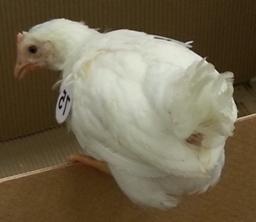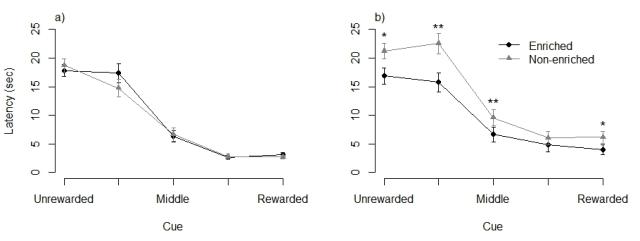Results of environmental influences

There were no differences in latency to reach the five different cues between treatments in the first cognitive judgment bias test. This means that the initial stressor, the cold stress, and the different housing regimes of environmental enrichment and barren pens had no effects on the moods of the chicks.
After the larger, collective, stressor there was, yet again, no effect of the initial cold stress. However, enrichment had a large effect with chicks living in non-enriched environments being slower to reach all cues (figure 1). This indicates that environmental enrichment can buffer the negative effects unpredictable stressors have on the mood of chicks.
The longer latencies to reach all cues seen for chicks living in non-enriched environments, including the rewarded cue, could be a sign of depression (Enkel et al. 2010, Richter et al. 2012) . This is based on the fact that depressed individuals show a reduced anticipation for positive events as well as an increased anticipation of negative events (Enkel et al. 2010, Richter et al. 2012). It is therefore possible that the environmental enrichment provided to the chicks in this study saved them from a depressed state of mind. This is an important finding for animals and humans alike and should be further investigated in future studies.

References
Enkel T, Gholizadeh D, von Bohlen und Halbach O, Sanchis-Segura C, Hurlemann R, Spanagel R, Gass P & Vollmayr B. 2010. Ambiguous-cue interpretation is biased under stress- and depression-like states in rats. Neuropsychopharmacology. 35, 1008-1015.
Richter SH, Schick A, Hoyer C, Lankisch K, Gass P & Vollmayr B. 2012. A glass full of optimism: Enrichment effects on sognitive bias in a rat model of depression. Cognitive, Affective, & Behavioural Neuroscience. 12, 527-542.
Responsible for this page:
Director of undergraduate studies Biology
Last updated:
05/05/15
